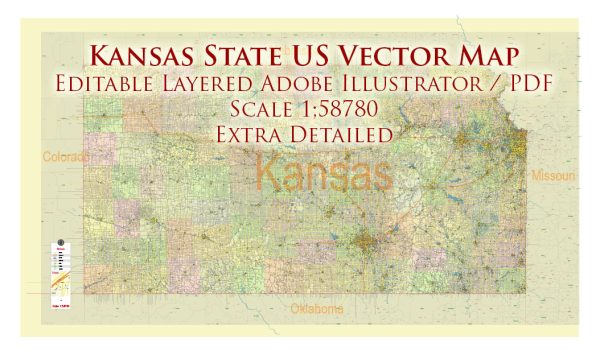A general overview of transportation infrastructure in Kansas, USA. Vectormap.Net provide you with the most accurate and up-to-date vector maps in Adobe Illustrator, PDF and other formats, designed for editing and printing. Please read the vector map descriptions carefully.
Roads and Highways: Kansas has an extensive network of roads and highways that connect various parts of the state and facilitate transportation. Major interstates, such as I-70 and I-35, traverse the state, connecting it to neighboring states and providing important east-west and north-south routes.
Bridges: Kansas has numerous bridges that span its rivers and waterways, ensuring efficient connectivity. The maintenance and improvement of bridges are crucial for the state’s transportation infrastructure.
Airports: Kansas is served by several airports, including commercial airports in major cities like Wichita, Kansas City, and Topeka. These airports play a significant role in both passenger and cargo transportation.
Railroads: Rail transportation is important for moving goods and commodities across the state. Kansas has an extensive rail network that connects it to other states and facilitates the transportation of agricultural products, industrial goods, and more.
Public Transit: While public transit options may be more limited in rural areas, urban centers like Wichita and Kansas City offer bus services. Additionally, some regions have commuter rail services to enhance public transportation.
Ports: Kansas is a landlocked state, so it does not have traditional seaports. However, the state is part of regional transportation networks that connect to ports on the coasts.
Infrastructure Maintenance and Improvements: Like other states, Kansas invests in the maintenance and improvement of its transportation infrastructure. This includes road repairs, bridge maintenance, and other projects aimed at enhancing the efficiency and safety of the transportation system.
It’s important to verify this information with more recent sources, as developments and changes in infrastructure can occur over time. You may want to check with the Kansas Department of Transportation or other relevant authorities for the latest and most accurate details regarding the state’s transportation infrastructure.


 Author: Kirill Shrayber, Ph.D.
Author: Kirill Shrayber, Ph.D.